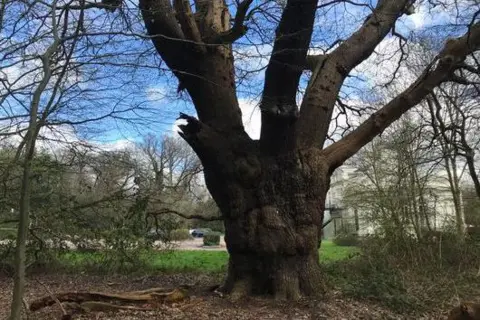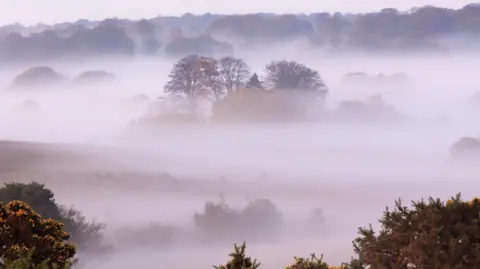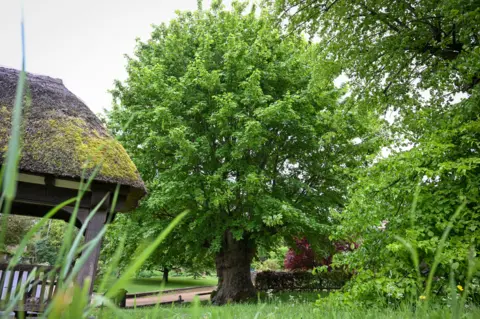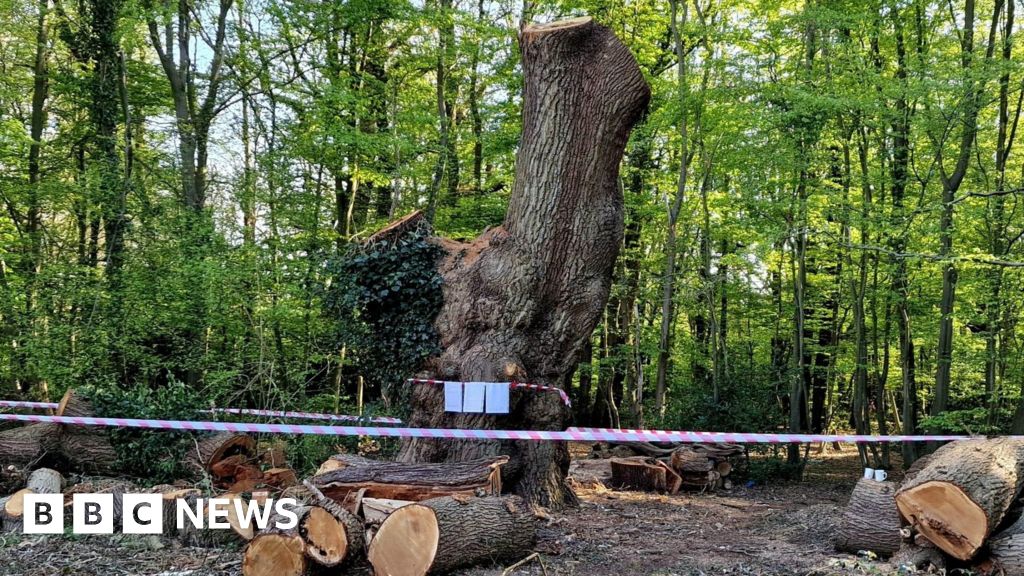The felling of a 500-year-old ancient oak in north London has led to an outpouring of anger, echoing the reaction when the Sycamore Gap tree is alleged to have been chopped down in September 2023.
What provokes such a response when these trees are destroyed, and do they have any protection?
When is a tree classed as ancient?
 Mark Saunders/Guardians of Whitewebbs
Mark Saunders/Guardians of WhitewebbsNot surprisingly, the length of time that a tree has existed is the main reason for a specimen to be classed as ancient.
“Ancient trees are those which have passed beyond maturity and are into the ancient life phase – which for some trees can be the longest stage of their life,” explains Dr Ed Pyne, senior conservation adviser for trees at conservation charity the Woodland Trust.
The amount of time for this to happen varies for different types of trees, with some taking more time to pass maturity.
A birch tree can be classed as ancient when it reaches 150 years old because of its fast-growing nature, while a slow-growing yew tree would not receive the same accolade until it was around 800 years old.
Such age means they tend to be low, squat trees which have a small canopy and a very wide trunk that is often decaying and hollow.
There are also trees known as veterans, which may not necessarily be as old, but they have similar characteristics to ancient trees with high amounts of decay like heart rot.
Such decay was “not a disease and not a cause for concern” but “a normal, healthy kind of part of the trees’ physiological development”, said Dr Pyne.
How many ancient trees are there in Britain?
 Getty Images
Getty ImagesThe Woodland Trust runs an Ancient Tree Inventory, which lists more than 190,000 of the UK’s oldest and more important trees, although Dr Pyne points out it is still only “a snapshot and quite incomplete”.
Ancient trees can be found across the country on both public and private land, with the most surviving examples to be found in what were once extensive royal hunting grounds like the New Forest and Windsor Great Park.
Others can be found in places as diverse as housing estates, urban parks, village greens and churchyards.
Britain is known as being particularly rich in ancient trees, with the country having more ancient and veteran oak trees than anywhere else in Europe.
Dr Pyne said this was generally down to historic factors like the existence of large hunting grounds which have protected the trees from development over the years.
Why are ancient trees important?
 Getty Images
Getty ImagesThe decaying nature of ancient and veteran trees is one of their key characteristics because of the microhabitats they offer to wildlife, providing homes and food to everything from fungi and lichen to bats and birds.
The huge length of time that the decay takes to develop also makes these sites much rarer and richer compared to younger trees.
One study found it takes over 200 years for heart rot to start developing in oaks, with substantial amounts of it only occurring after around 400 years.
“Some of the biodiversity associated with this decay can be very, very specialised and some species that utilise these habitats can be very rare.
“Many of them are threatened simply because there’s not a lot of this,” Dr Pyne says.
There is also the historical element of ancient trees, linking them to past periods of time.
For example, the Tolpuddle Martyrs’ Tree, an ancient sycamore in Dorset, is regarded as the birthplace of the trade union movement, being where farm workers met in 1834 to protest over wages.
As for the Enfield oak, it “would have been a young tree when Guy Fawkes was devising the Gunpowder Plot at nearby Whitewebbs House“, said Dr Pyne.
And finally, there is the cultural value that ancient trees provide, with people creating their own connections to them.
“We’ve all got trees that we remember from our childhood. That was the tree everyone met at the park, or where you met on your first date,” he said.
This was particularly the case for the Sycamore Gap tree, which was not classed as ancient, having been planted in the late 1800s, but became iconic because of its position beside Hadrian’s Wall and its use in the 1991 film Robin Hood: Prince of Thieves.
Do ancient trees have any protection?
 Getty Images
Getty ImagesThere are several policies and pieces of legislation in place which provide some protection for ancient and veteran trees in Britain, including:
- Tree protection orders, known as TPOs, which can be issued by local authorities for specific trees or woodlands and mean written permission must be sought before any work can be done on them
- Legal protection is provided when an ancient tree is based in a conservation area or somewhere like a Site of Special Scientific Interest (SSSI)
- Felling licences must be sought from the Forestry Commission when the quantity of timber to be felled is over five cubic metres
- National planning policy framework defines ancient and veteran trees as irreplaceable, meaning that a local authority should not approve planning which could lead to a loss of these habitats unless in exceptional cases, such as national infrastructure work
Dr Pyne believes such legislation is “pretty good” when it comes to protecting trees, although improvements could be made.
Indeed, a joint report issued this week by the Tree Council and Forest Research warned that trees were only indirectly protected by the law and called for a more “robust and effective system”.
What happened with the Enfield oak?
 Woodland Trust/PA Media
Woodland Trust/PA MediaThe oak, which was cut down on 3 April, was located on the edge of council-owned Whitewebbs Park and overlooked a Toby Carvery.
Mitchells & Butlers, which owns Toby Carvery, said on Tuesday that it was responsible for chopping down the pedunculate oak, which had been done “to protect our employees and guests as well as the wider general public”.
However, Enfield Council told the BBC a recent inspection carried out on the tree found it could have lived for several more centuries.
Dr Pyne said the tree had “fallen through the gap” in terms of legislation.
“It didn’t have a tree preservation order, it’s not in a conservation area, and although there’s been lots of planning applications in the area surrounding this tree, there hasn’t been any planning application in the direct area of the tree, and so the planning policy framework hasn’t kicked in.
“The loss is a tragedy, really,” he added.

